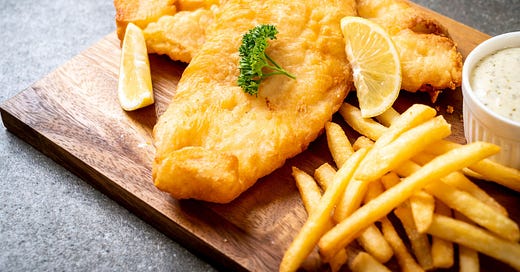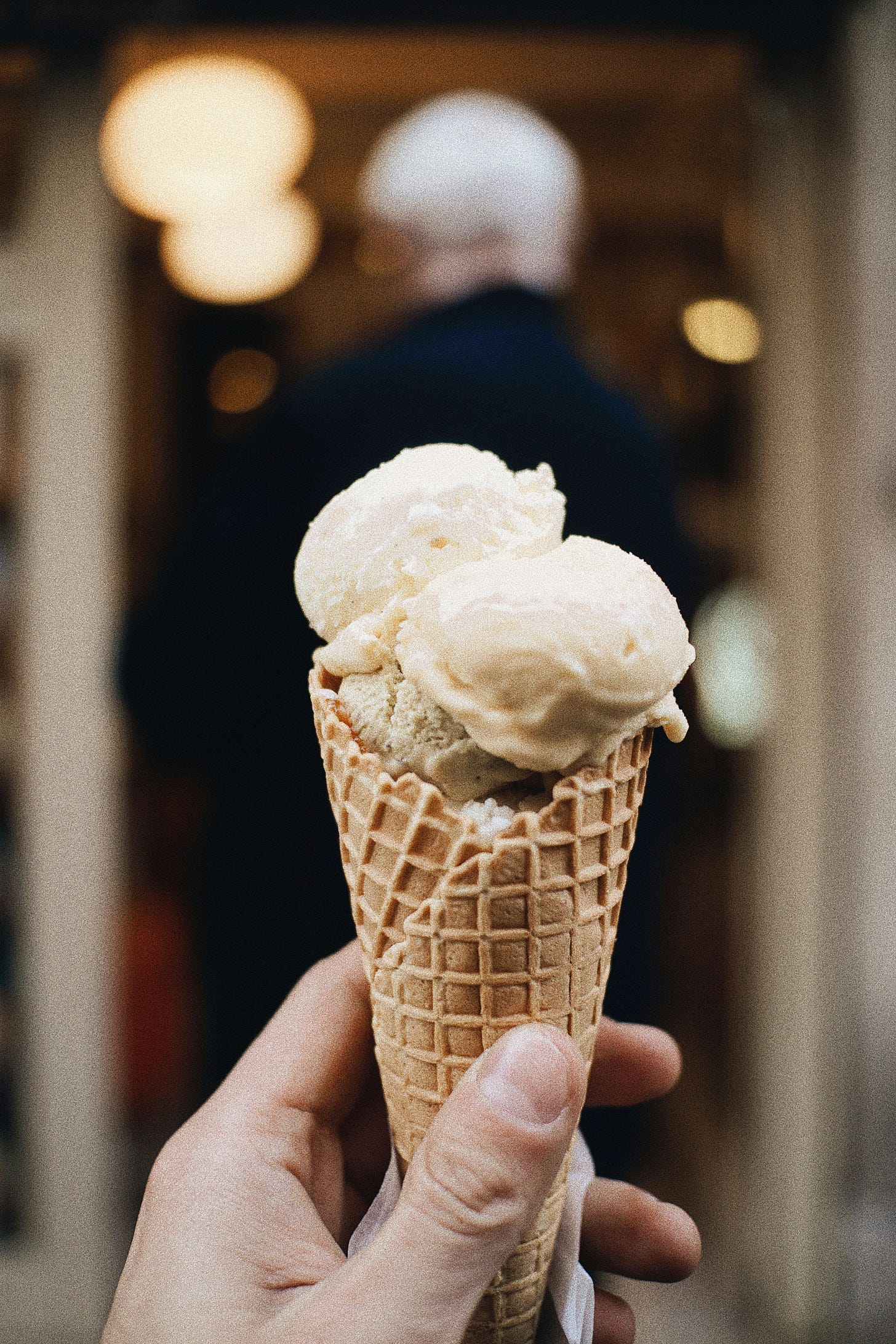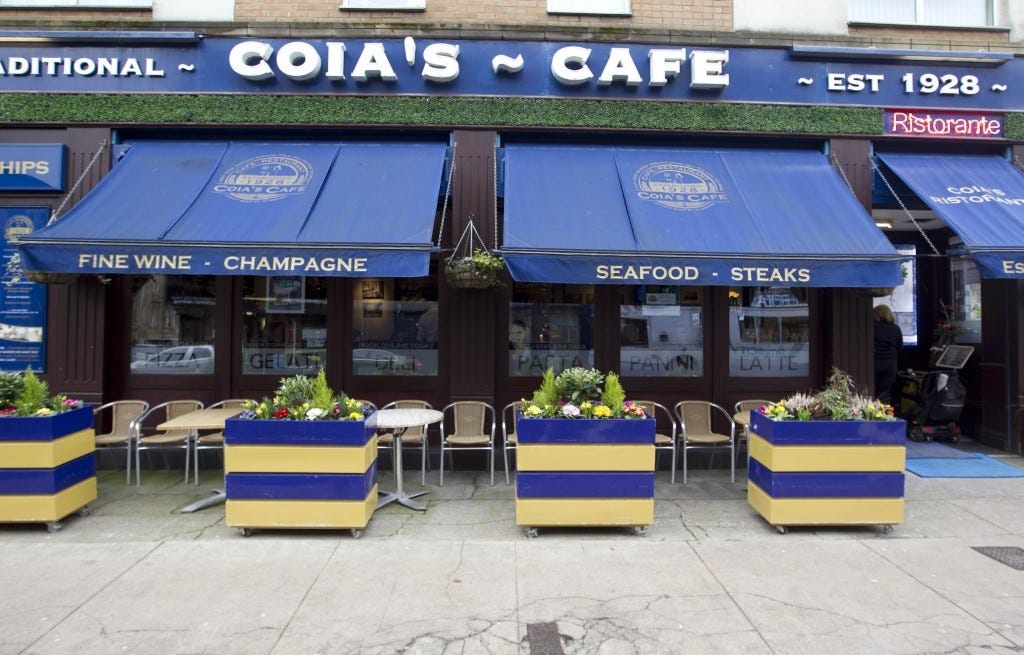Recently we spent some time in Italy. We toured around Sorrento, Positano, Amalfi, Pompeii, Capri, visited a winery, a Mozzarella farm, made pizzas, ate at a Michelin star restaurant. We packed a lot in. The highlight though was our cook-school classes with Chef Carmen where we learned how to make pasta, gnocchi, tiramisu and many other typically Italian dishes.
Click on the image to see Carmen’s recipe book
We drank Lemoncello, ate well and had a great time with our host Chef Carmen. Obviously we talked about food but were surprised to find during our conversations that the Italian influence on Scottish cafe life was almost unknown. That set us thinking and with a bit of research we pulled together a short history. We have only scratched the surface here and will no doubt be revisiting this topic in the future.
From the famous University Café in Glasgow to the queued-out Janetta’s Gelateria in St Andrews, nearly every town or city in Scotland boasts a thriving ice cream cafe. Largs, Ayr, and Eyemouth are other unlikely places where you can enjoy award-winning gelato despite the howling gales.
Better still, many of these ice cream shops come with a chippy attached. Meaning you can order a fish tea (battered haddock, chips, buttered bread and a pot of tea) and wash it down with an ice cream sundae for dessert.
Chippies and ice cream parlours have become such an integral part of Scotland’s takeaway scene that perhaps we take them for granted. Public records show that as early as 1905 there were 336 ice cream parlours and chippies in Glasgow alone. But where did they come from?
Many outside Scotland are unfamiliar with the flavoursome history between Italian immigrants and the Scots’ sweet tooth. To get the scoop on this special relationship, we need to go back to nineteenth century Italy.
Italian immigration to Scotland
Italian Scots make up around 1.9% of Scotland’s population. Most of them can trace their ancestry to the late nineteenth century, when countless working class Italians fled poverty and corruption in search of a better life.
Initially, the immigrants pinned their hopes on America, with the UK as a stopping off point. But when America tightened its immigration policies, they found themselves stranded. While some settled in England and Wales, many travelled north to Scotland. Despite facing hardship and suspicion from locals, the intrepid Italians refused to give up.
Hokey pokey men
Unable to ply their native trade in wine or olive oil production, the immigrants had to find a new way to earn a crust. Using cylindrical zinc drums with a wooden barrel inside they made ice cream from the fresh, creamy cow milk that was readily available in rural Scotland. Salt and ice, also plentiful, were the other key ingredients. Churning the mixture by hand took time and strength — a far cry from today’s at-home ice-cream makers. Once the ice cream was ready, the vendors would take to the streets with their barrows crying, “ecco un poco!”
The vendors’ rallying cry to potential punters earned them the nickname ‘hokey pokey’ men. Some trace the origin of the phrase to the Italian for “here’s a wee bit”. Turns out, Scots with a sweet tooth couldn’t resist!
Luckily, Italian sunshine wasn’t a prerequisite to enjoyment and the creamy, luxurious treat took off. In those days, the ice-cream makers rose at the crack of dawn to laboriously crank the frozen cream by hand. It had to be made fresh to attract the crowds on typically dreich streets.
Not so fresh, however, was the unsanitary ‘cleaning’ of the ice cream dishes. Vendors would simply wipe ice-cream and dribble from the ‘penny lick’ glass with a rag before adding a scoop of fresh ice cream for the next punter. As a result, ‘hokey-pokey ice-cream’ started to become synonymous with grotty, inferior ice-cream that turned customers’ stomachs. The penny lick was eventually banned due to the spread of diseases like cholera, tuberculosis. Thankfully, hygiene standards have improved.
The chippy tea takes off
From ice cream, the hokey pokey men branched out into savoury delights. Establishing their own restaurants, they began to make use of classic produce that Scotland had in bountiful supply: fish and potatoes.
Many of the Italian chippies and ice cream parlours were part of chains bought by employees confident of their ability to turn a profit. In the colder months these businesses did a roaring trade in hot, battered fish with vinegar drizzled chips, while in the summer the demand for ice cream skyrocketed.
University Café on Byres Road and Coia’s Café are just two Italian businesses that emerged in Glasgow, beloved by locals and visitors alike. From delicacies like battered fish, pizza, and macaroni to the irresistible ice cream oyster, these humble cafés became local institutions.
Joe Brattissani claims to have opened the first chippy in Scotland. His daughter, Mrs Qualatta, is remembered fondly by soldiers who enjoyed the crispy, battered haddock served from her café on Leith Walk, Edinburgh.
Not everyone screams for ice cream
The ice cream revolution earned a frosty reception from some Scots, however. Presbyterian resentment stirred over the predominantly Catholic ice cream cafés, and they were branded ‘one of the evils of Glasgow’.
During the early 1900s, the city’s population enjoyed greater religious freedom, indulging in dining-out and dance halls. Fun-loving Glaswegians embraced the Italian cafes, particularly teenagers. However, the Italian-run establishments were viewed as dens of iniquity by more conservative members of the community. In 1907 the United Free Church met to discuss the ‘Ice Cream Hells’ that traded on Sundays and corrupted local youths. Fortunately for Glaswegian taste buds, the Italian cafés survived and became a fixture of Scottish cuisine.
Today, Glasgow has the third-biggest Italian population in the UK, and the cultural impact of Scots Italians has left a mark beyond catering. Singer Paolo Nutini, artist Jack Vettriano, and virtuoso violinist Nicola Benedetti are just three famous Scots with Italian roots.
Menus may have become fancier over the years with unusual ice cream pairings like rice pudding or tea and biscuits, but deep-fried haddock and chips with a scoop of vanilla ice cream to follow remains the undisputed classic of Scottish-Italian cafés.
The only question remaining is where you sit on the Scottish culinary divide. Salt ‘n’ sauce (Edinburgh) or salt and vinegar (everywhere else)?








